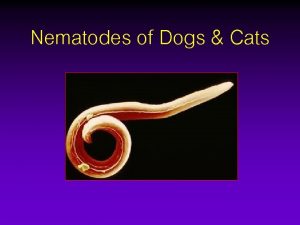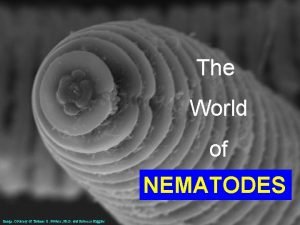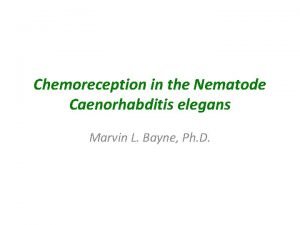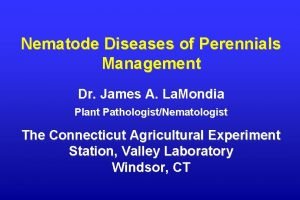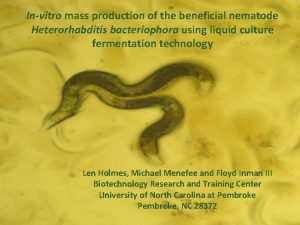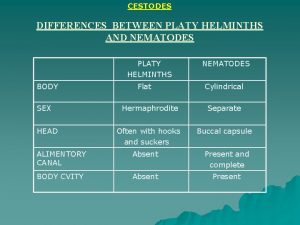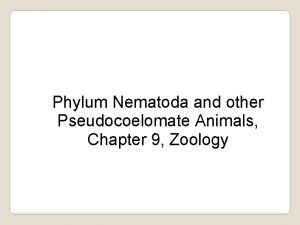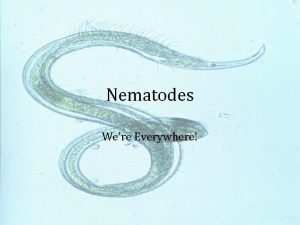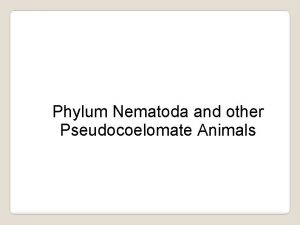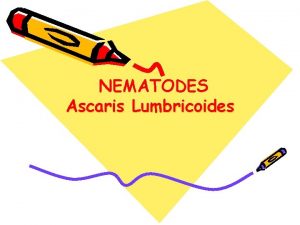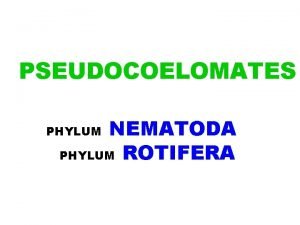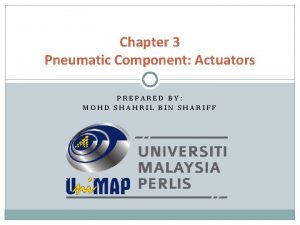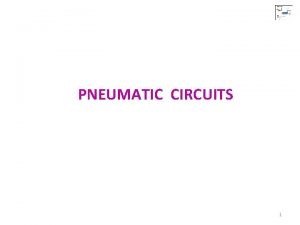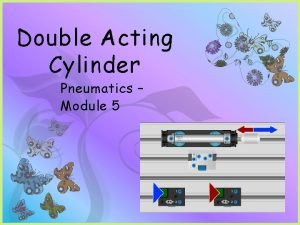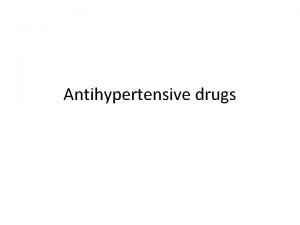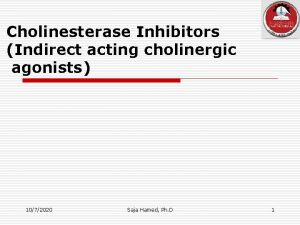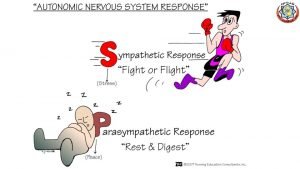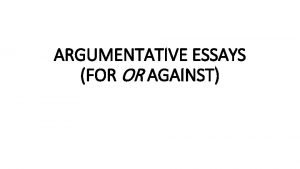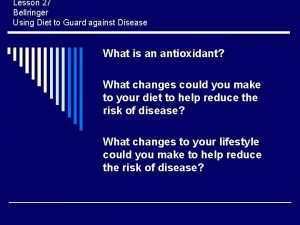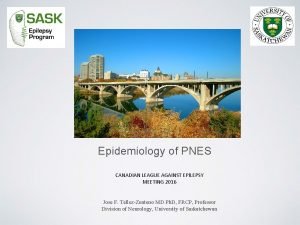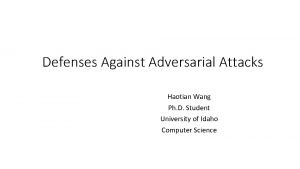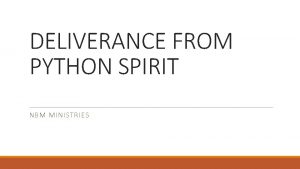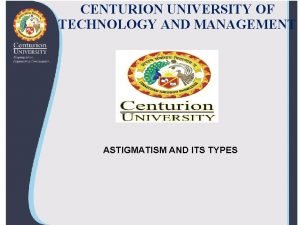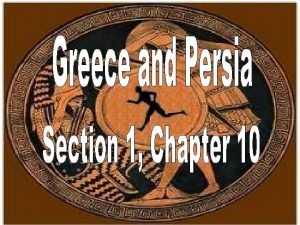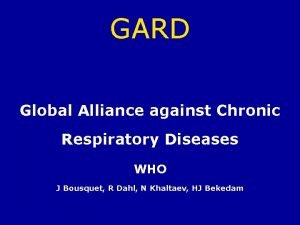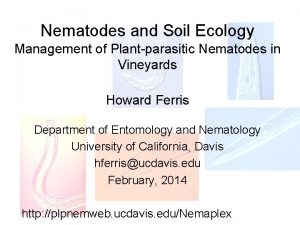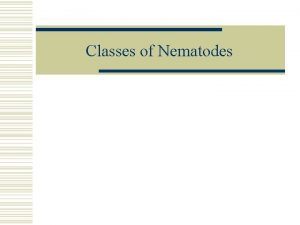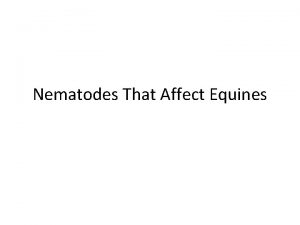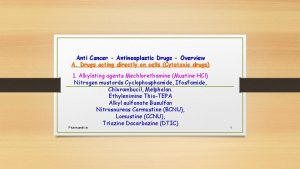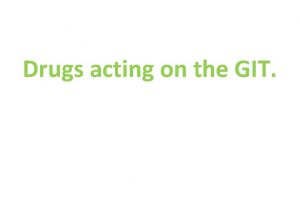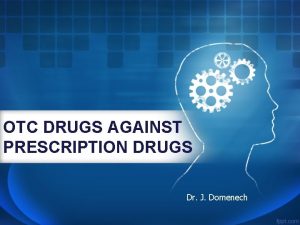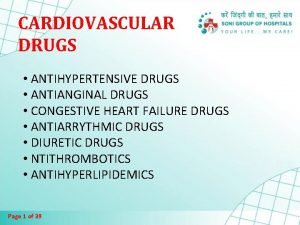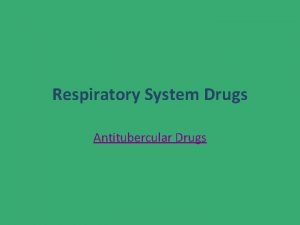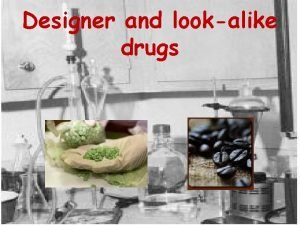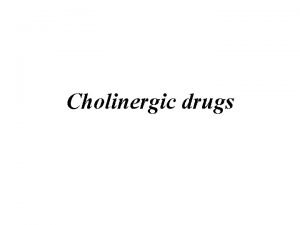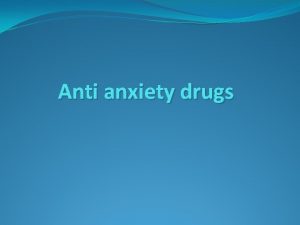Drugs acting on against nematodes Antinematodes Drugs acting


































































- Slides: 66

Drugs acting on (against) nematodes (Anti-nematodes)

Drugs acting on (against) nematodes (Anti-nematodes) These are drugs which are used for prevention and treatment (control) of nematodes infection in different animals and birds. They are classified according to the origin into: I- Plant origin anti-nematodes: 1 - Nicotine sulphate:

Origin: It is obtained from tobacco plant (Nicotiana tobacco plant) It can be prepared synthetically as sulphate salt. Administration: a- It is given orally as a drench as nicotine sulphate salt. Mechanism of action: (Vermifuge) 1 - It is a Parasympathomimetic drug acts on nicotinic receptors at the neuromuscular junction causing depolarization followed by persistent depolarization → spastic muscular paralysis followed by expelling of worms.

2 - It causes an increase in GIT motility → expelling a live worms. Efficacy: It is effective against Ascaris and Trichostrongylus in ruminants.

2 - Chenopodium: Origin: It is a pale yellow volatile oil obtained by distillation of Chenopodium plant species. Chenopodium ambrosiodes (Mexican tea, Indian Worm seed) in South America Administration: It is given orally in gelatinous capsules. Mechanism of action: Oil contains a mixture of volatile substances and active principle (Ascaridol) which causes muscular paralysis of the parasite and increasing the motility of GIT expelling the parasite (Vermifuge). The oil is active against Strongylus worms in horses and Ascarids worms in pigs, dogs and cats.


3 - Santonin: (Wormseed, Santonica, Drooping Sea, wormwood, See mugwort. Origin: It is A pale yellow powder obtained from Artemisia maritima plant. Santonin is a drug which was widely used in the past as an Anthelmintic, a drug that expels parasitic worms (helminthes) from the body, by either killing or stunning them

Mechanism of action: It is an irritant substance which irritates and stimulate both intestinal and parasite contraction promoting its expelling outside the body. The drug has a Vermifuge action, for Ascarids in particular. Their muscles are paralyzed by Santonin and they are forced into the large intestine where they are removed by means of a laxative. Efficacy: It is effective against Ascarids in dogs and cats.

II- Synthetic Anti-nematodes: 1 - Piperazines: Mechanism of action: (Vermifuge) a- It is a GAPA receptor agonist acts by reversibly inhibiting neuromuscular transmission in the worm by acting like GABA on chloride channels in the worm muscles → hyperpolarization → paralysis of the worm (flaccid paralysis). b- It decreases the response to acetylcholine by muscles of worm, leading to decreased action of acetylcholine on neuromuscular junction. This leads to decreased contraction and flaccid paralysis. c- The paralyzed worms are expelled alive by normal peristalsis.

Efficacy: It is effective against : a- Ascarids in dogs b- Ascaridia and Capillaria in poultry. Uses: - It is used for treatment of Ascarids, Oxyuris and Nodular worms in all animals and poultry. - It is a administered as piperazine citrate or phosphate salts and given orally as a drench or added to drinking water for poultry. - It is safe in pregnancy.

2 - Diethylcarbamazine: Chemistry: It is a Piperazine derivative Mechanism of action: Diethylcarbamazine antagonizing the phospholipase A 2 activity (the metabolic enzyme that metabolizes arachidonic acid of phospholipids of cell membrane) and also inhibits cyclo-oxygenase enzyme activity in the endothelial cells of both parasite and the host → inhibiting the production of → prostaglandin PGI 2, (prostacyclin) and PGE 2 (that produces a tonic dilation of blood vessels and inhibits aggregation of neutroplails and eosinophils) but does not affect platelet production of thromboxane.

→ Consequently, there is then a vasoconstriction, amplified endothelial adhesion and immobilization of the microfilariae and cytotoxic activity by the host platelets and granulocytes. NB: It appears that Diethylcarbamazine activates an innate immune response rather than an adaptive immune response


Efficacy and uses: 1 - It is used as a prophylactic for heartworms disease. 2 - It is used in the treatment of ascariasis 3 - It is used in control of parasitic bronchitis (Dictyocaulus viviparous in sheep and cattle. NB: 1 - It is contraindicated in dogs with microfilaria because of sudden death 2 - It may cause infertility in male.

3 - Benzimidazoles: - Chemically related group of drugs with anthelmintic, fungicidal and antibacterial activities. -Some of them are of antineoplastic activities. - They act by conversion inside the cell into methylbenimidazole which is effective agent that cause degenerative changes in the intestinal cells of the parasitic nematodes by interaction with cytoplasmic microtubules. - They are almost all teratogenic and contraindicated in pregnant animals.

- Benzimidazoles are very safe anthelmintics ; a wide safety margin from 1: 20 for albendazole to 1: 100 for fenbendazole (very safe). - Cambendazole , Oxfendazole and Parbendazole have embryotoxic and teratogenic effects → not given to pregnant animals. - Albendazole leave tissue residues therefore 10 days from the last dosing of sheep and 14 days from the last dosing of cattle must be elapsed before slaughtering animals. - Cows producing milk for human should not treated with Albendazole. - Fenbendazole withdrawal time= 14 days for meat and 3 days for milk - Tricalbendazole withdrawal time = 28 days and not use to animals providing milk.

- Benzimidazoles have a good activity against GIT nematodes, lung worms and their larvae. - The recent drugs Mebendazole and Oxfendazole are highly effective against both nematodes and cestodes (broad spectrum ). - Albendazole active against adult liver flukes, cestodes and GIT nematodes larvae (broad spectrum , vermicide, oral anthelmintic). - On contrast, Tricalbendazole is highly active against liver flukes (fasciolicide), but has no activity against nematodes and cestodes.

Mechanism of action of Benzimidazoles: - The molecular mode of action of all benzimidazoles consists in binding to tubulin, a structural protein of microtubules. These microtubules are important organelles involved in the motility, the division and the secretion processes of cells in all living organisms. - In the worms the blocking of microtubules perturbs the uptake of glucose, which eventually empties the glycogen reserves. This blocks the whole energy management mechanism of the worms that are paralyzed and die or are expelled. - Since cell division is also disturbed worm egg production and development is also blocked by benzimidazoles, i. e. they also have an ovicidal effect.

They include: A- Fenbendazole. B- Mebendazole. C-Thiabendazole. D- Oxibendazole. E- Oxfendazole. F- Albendazole. G- Cambendazole. H-Triclabendazole. I- Flubendazole.

A- Thiabendazole: - It is the protoypic benzimidazole - It is approved for use in ruminants and horses. - It is used as a parasiticide to control roundworms, hookworms, and other helminthes species which attack wild animals, livestock and humans

Mechanism of action: The precise mode of action on the parasite is unknown, but it may inhibit the helminth-specific enzyme fumarate reductase and impairing glucose transferring and ATP-synthesis. 1 - It acts by inhibiting fumarate reductase enzyme which catalyzes the formation of succinate from fumarate. 2 - Interference with the formation of succinate → leads to inhibition of ATP formation.

Pharmacokinetics: 1 - Thiabendazole is relatively well absorbed (for a Benzimidazoles) and is distributed throughout body tissues. 2 - Peak levels occur in approximately 2 -7 hours after dosing. 3 - It is rapidly metabolized in the liver by hydroxylation, glucuronidation and sulfate formation. 4 - Within 48 hours of dosing, 90% of the drug is excreted in the urine (as metabolites) and 5% in the feces. 5 - Less than 1% of the drug is excreted in the urine unchanged. 6 - Five days after a dose, the drug is virtually eliminated from the body.

Efficacy : 1 - Thiabendazole is vermicidal and/or vermifugal against Strongyloidea, Ascaroidea and Trichonelloidea 2 - Its effect on larvae of Trichinella spiralis that have migrated to muscle is questionable. 3 - Thiabendazole also suppresses egg and/or larval production and may inhibit the subsequent development of those eggs or larvae which are passed in the feces. 4 - It also has antifungal and antibacterial activities.

Uses: 1 - It has been used for removal of Ascarids, Strongyloides and Filaroides in dogs. 2 - It is used in treatment of GIT nematodes (Haemonchus species, Ostertagia sp. , Trichostrongylus sp. ) in sheep, goat and cattle. 3 - It is used for treatment of Strongylus spp. , Oxyuris spp. , and Parasacaris spp. in horse.

3 - It is also used as antifungal drug in treatment of nasal Aspergillosis in animals. NB: A- Thiabendazole is one of the safest antinematodal drugs because fumarate reductase enzyme does not present in mammals. B- It is contraindicated in pregnant animals due to teratogenic effect.

B- Fenbendazole : (Panacur) 1 - It has a broad spectrum activity against nematodes and other certain species of cestodes (tapeworms). . 2 - It should be given for 3 successive days. Pharmacokinetics: 1 - It is well absorbed orally. 2 - It is metabolized in the liver o active compound Oxfendazole and sulfone. 3 - It is mainly excreted in feces.

Uses: 1 - Treatment of Ascarids, Hookworms, whipworms and cestodes in dogs 2 - Treatment of Haemonchus, Ostertagia and Trichostrongylus species in cattle. 3 - Removal of large Strongyles in horses. NB: Fenbendazole should not be given with bromosalans (fasciolicide drug) in pregnant cattle or sheep because of induction of abortion.

C- Oxfendazole: 1 - It is a sulphoxide metabolite of Fenbendazole. 2 - It is mainly excreted in feces within 48 hours. 3 - It has withdrawal period of 14 days. 4 - It has embryotoxicity to pregnant animals (contraindicated in pregnant animals). 5 - It has broad spectrum activity against nematodes and cestodes (tapeworms). Mechanism of action of Oxfendazole: In the worms the blocking of microtubules perturbs the uptake of glucose, which eventually empties the glycogen reserves. This blocks the whole energy management mechanism of the worms that are paralyzed and die or are expelled.

D- Mebendazole: 1 - Mebendazole inhibits the formation of the worms’ microtubules (inhibits polymerization) and causes the worms’ glucose depletion. 2 - It has a broad spectrum activity including round worms, hookworms, whipworms and some cestodes (Taenia pisiforis but not effective against Dipylidium caninum) in dogs and horses 3 - It has some antifilarial activity. Disadvantages: 1 - It causes liver damage in dogs. 2 - It has withdrawal period of 7 days in sheep.

Mechanism of action: Mebendazole acts by inhibiting the production of microtubules via binding to colchicine binding-site of β-tubulin and thereby blocking polymerization of tubulin dimers in the intestinal cells of parasites causes the worms' glucose depletion.



E- Oxibendazole: 1 - It is effective against GIT nematodes and lung worms. 2 - It is used in combination with Diethylcarbamazine for prevention of heartworms and hookworms infections in dogs. 3 - It is mainly excreted in urine within 9 days. 4 - It has withdrawal period of 14 days.

F- Albendazole: Mechanism of action: 1 - It inhibits the polymerization of the parasite (tubulin) into microtubules (there is a higher affinity of Albendazole to the parasite tubulin and so the activity is mediated mainly against the parasite rather than on the host). The loss of the cytoplasmic microtubules → impaired uptake of glucose by the larval and adult stages of the parasites →the worm is then unable to maintain energy production → leads to immobilization and eventual death.

2 - the inhibition of the enzyme fumarate reductase, which is helminthes-specific. Pharmacokinetics: It is metabolized in the liver into active metabolites (sulphone and sulphoxide) which are effective against liver fluke and cestodes. Uses: 1 - It is a broad spectrum anthelmintic drug used against nematodes, cestodes and liver flukes (Fasciola). 2 - Albendazole is the drug of choice for treatment of intestinal round worms as Ascaris , hook worm (Ankylostoma ) thread worm (Strongyloids) , pin worms (Enterobius) and whip worm (Trichuris trichuria) infestations, as a single dose repeated after 3 weeks.

3 - Albendazole is the main drug for Hydatid disease (dog tapeworm) twice / day for 1 month and repeat after 2 -3 weeks if required up to 3 courses. 4 -Used for treatment of tissue round worm (Trichnella spiralis) for 3 days. - NB: 1 - It causes embryotoxicity (teratogenic). 2 - It has withdrawal period of 10 -14 days.

G- Cambendazole: 1 - It is effective against nematodes. 2 - It is absorbed orally. 3 - It may cause death to cattle in large dose. 4 - It is embryotoxic (teratogenic) 5 - it has withdrawal period of 21 days.

H- Triclabendazole: 1 -Triclabendazole has shown no activity against nematodes. (It differs from the other Benzimidazoles e. g. , albendazole, mebendazole as these compounds have selective activity against nematodes and have no significant activity against liver fluke). 2 - It is mainly excreted in bile. 3 - It is rapidly metabolized in liver giving sulphoxide (the main metabolite) and sulphone ( lesser amount). 4 - It has withdrawal period of 28 days. 5 - It should not used in milking (dairy) animals. 6 - It is not teratogenic

Efficacy: 1 - It is a fasciolicidal drug (effective not only against the adult worms present in the biliary ducts, but also against the immature larval stages of Fasciola migrating through the hepatic parenchyma) 2 - It kills all hepatic stages of Fasciola (early immature, immature and mature stages). Mechanism of action: 1 - It penetrate into liver flukes by trans tegumentary absorption → inhibition of the parasite's motility (probably related to the destruction of the microtubules) → the death of the parasite. 2 -It causes changes in the parasite's resting tegumental membrane potential → strongly inhibiting the release of proteolytic enzymes ( a process that appears critical to the survival of the parasite)

Pharmacological action: Triclabendazole binds to tubulin impairing intracellular transport mechanisms and interferes with protein synthesis. Efficacy and clinical uses: Triclabendazole is specifically active against Fasciola. hepatica and F. gigantica. The unique efficacy of Triclabendazole against the early immature and immature Fasciola stages makes this product particularly useful for the treatment of outbreaks of acute and subacute fasciolosis and for the strategic control of Fasciola infections. In addition, the efficacy against the 3 stages accelerates clinical recovery.

Pharmacokinetics: After oral administration, 50 -75% of the dose of triclabendazole is absorbed from the gastrointestinal tract. It is then rapidly metabolized to its sulphoxide and sulphone metabolites. The sulphoxide is thought to be the active part. The vast majority of oral dose triclabendazole is eliminated in faces after 7 days. Urinary excretion is minimal. Less than 1% is excreted in milk. Therapeutic indications: Triclabendazole is a highly effective for treatment and control of acute and chronic fascioliasis in cattle. Its outstanding efficacy is demonstrated by its lethal action on early immature, immature and adult stages of Fasciola hepatica and F. gigantica.

Side-effects: Triclabendazole is very safe anthelmintic, which can be administered to stressed, sick or debilitated cattle of all ages. It can be used to treat pregnant cows. No contraindications are reported. Withdrawal period: Meat 28 days, milk 7 -10 days.

I- Flubendazole: 1 - It is used against nematodes only in pigs and birds. 2 - It is poorly absorbed orally. 3 - It is a safe drug even at high doses. 4 - It has withdrawal period of 14 days. 5 - It acts by inhibiting synthesis of cytoplasmic microtubules (Flubendazole inhibited tubulin polymerization by binding tubulin).

4 - Organophosphates: Their use is declining due to: a- Their relative toxicity. b- Limited efficacy against immature stages. c- Narrow margin of safety. d- Contamination of the environment through fecal excretion. Mechanism of action: They act by inhibiting cholinesterase enzyme activity in parasite (irreversibly) → inhibiting acetylcholine destruction → accumulation of acetyl choline → spastic paralysis of parasite.

A- Haloxon: It is an organophosphorus compound. Mechanism of action: They act by inhibiting cholinesterase enzyme activity in parasite (irreversibly) → inhibiting acetylcholine destruction → accumulation of acetyl choline → spastic paralysis of parasite. Efficacy and uses: 1 - It is effective against adult GIT nematodes in cattle. 2 - It is effective against fly larvae. NB: Salivation and diarrhea may be seen in foals.

B- Dichlorvos: It is an organophosphorus compound. Pharmacokinetics: 1 - Because of its high volatility , it is incorporated into polyvinyl resin pellets. 2 - Dichlorvos is released slowly from the inert pellets as they pass through the GI tract → providing a therapeutic concentration along the tract. 3 - When passed in the feces, the pellets still contain (45 -50% ) of the original drug → killing fecal larvae. 4 - Dichlorvos is rapidly absorbed and metabolized in the body.

Mechanism of action: They act by inhibiting cholinesterase enzyme activity in parasite (irreversibly) → inhibiting acetylcholine destruction → accumulation of acetyl choline → spastic paralysis of parasite. Efficacy and uses: 1 - Treatment of Toxocara cati and Toxocara canis in cats and dogs. 2 - Control of bots, pinworms, large and small bloodworms and large nematodes in horses. 3 - Control of fly, fleas and ticks (as spray).

C- Coumaphos: 1 - It is an organophosphorus compound. 2 - It is approved for use in cattle to control stomach worms, whipworms and cooperia 3 - It is used as feed additive for 6 successive days. Mechanism of action: They act by inhibiting cholinesterase enzyme activity in parasite (irreversibly) → inhibiting acetylcholine destruction → accumulation of acetyl choline → spastic paralysis of parasite.

D- Trichlorfon: 1 - Trichlorfon is not effective but, it must be converted to Dichlorvos to be effective. 2 - It inhibits cholinesterase (inhibits acetylcholine destruction) for 2 -3 weeks. 3 - It the safest organophosphate , so can be used in fish farms. 4 - It is metabolized rapidly. 5 - It is approved for use in horse, pigs and dogs.

5 - Macrocyclic lactones (Avermectins and milbemycins): Chemistry: -Avermectins and milbemycins are a family of 16 -membered macrocyclic lactones which have a novel mode of action against a broad spectrum of nematodes and arthropods. Macrocyclic lactones are products or chemical derivatives of soil microorganisms belonging to the genus Streptomyces. - Avermectins were first found in the fermentation broth of a soil microorganism actinomycete (Streptomyces avermitilis) at the Kitasato Institute in Japan. - The avermectins in commercial use are ivermectin, abamectin, doramectin, eprinomectin, and selamectin. Commercially available milbemycins are milbemycin oxime and moxidectin.

-The macrocyclic lactones have a potent, broad antiparasitic spectrum at low dose levels. - They are active against many immature nematodes (including hypobiotic larvae) and arthropods. - The published literature contains reports of use to treat infections of >300 species of endo- and ectoparasites in a wide range of hosts. - Moreover, a single therapeutic dose can persist in concentrations sufficient to be effective against new nematode infections for prolonged periods after treatment.

-Eight different Avermectins were isolated in 4 pairs of homologue compounds, with a major (a-component) and minor (b-component) component usually in ratios of 80: 20 to 90: 10. - Eight natural avermectin components, namely A 1 a, A 1 b, A 2 a, A 2 b, B 1 a, B 1 b, B 2 a, and B 2 b, were discovered. Ivermectin: It is an antibiotic extracted from S. avermitilis Chemistry: Ivermectin (22, 23 -dihydroavermectin B 1 a + 22, 23 -dihydroavermectin B 1 b) is a broad-spectrum antiparasitic avermectin medicine.

Pharmacokinetics: Avermectins can be absorbed orally, parenterally and dermally. a- In simple stomach animals (about 95% of the dose) was absorbed orally. b- In ruminants (about 25%-30% of the dose) was absorbed orally. c- It is distributed to most tissues except CSF (not cross BBB). d- It has long duration of action (2 -4 weeks). e- It has withdrawal period of 35 days in cattle. f- It should not use in lactating cows. g- Avermectins are largely excreted into the bile and feces, and urinary excretion accounts for only 0. 5% to 2. 0% of the administered doses.

Mechanism of action: -The Avermectins block the transmission in nerves and muscle cells by stimulating the release and binding of presynaptic inhibitory neurotransmitter Gamma-Amino Butyric acid (GABA) at nerve endings. -This causes an influx of chloride ions into the cells leading to hyperpolarization and subsequent paralysis of the neuromuscular systems. -GABA receptors are found at the neuromuscular junctions and the central ventral cords in nematodes, whereas in mammals they are found primarily in the brain. -Ivermectin does not readily cross the blood brain barrier in mammals at therapeutic doses.

NB: Trematodes and cestodes have natural resistance against ivermectin since they do not use GABA as peripheral nervous system neurotransmitter. - Also, ivermectin acts by binding the glutamate- gated and glycine gated chloride (Cl-) channels of the parasite preventing their closure resulting in hyperpolarization of the cell membrane with no nervous signal can transmitted and muscular paralysis.

Uses: In ruminants: It is used for treatment of mature GIT nematodes, lung worms and external parasites. It is given by S. C injection only. In horses: It is used for treatment of bots, stomach worms, strongyles, pinworms and ascarids. In dogs: -It is effective against ascarids, hookworms, whipworms and microfilaria and prevention of heartworm disease. NB: It is used for control of ectoparasites in all species

Adverse effects: 1 - Local irritations especially at the site of S. C injection. 2 - CNs depression. 6 - Nicotine like compounds: 1 - Imidazothiazoles: Levamisole: -It is an anthelmintic and immunomodulator belonging to a class of synthetic imidazothiazole derivatives. - It is effective against adult and larval stages of GIT nematodes and lung worms.

-It is an immunostimulant (modulates cell mediate immune responses). - Its therapeutic index is low in animals especially in horses and dogs Mechanism of action: 1 - Its anthelmintic activity is owing to stimulation of nicotinic acetylcholine receptors in nematodes muscle → causing spastic paralysis of susceptible nematodes→ expulsion. Also, this agonistic action reduces the capacity of the males to control their reproductive muscles and limits their ability to copulate. 2 - Levamisole at large doses inhibit carbohydrate metabolism by inhibiting fumarate reduction and succinate oxidation

-The net result is a paralyzing effect on worm which is then expelled alive, so its effect is considered a nicotine like. 3 - It is an immunostimulant (immunoregulatory or immunomodulator) modulates cell mediate immune responses by restoring T-cell function NB: It mimics the thymic hormone thymopoietin, it stimulate lymphocytes by its imidazole component. Physiologically, thymopoietin affects many components of the immune system including both neutrophils, macrophages, and lymphocytes and its therapeutically important actions are probably targeted at stimulation of phagocytosis and stimulation of regulatory T cells to restore homeostasis in a perturbed immune system.

Uses: 1 - In ruminants it is used for control of mature GIT and lung worms infection. 2 - In dogs it is used for treatment of microfilaria and heart worms 3 - In pigs it is used for treatment of ascarids, internal threadworms, lung worms and kidney worms. Adverse effects: 1 - It has narrow safety margin especially following injection. NB: Its therapeutic index is low in animals especially in horses and dogs

-The signs of toxicity including parasympathetic stimulation, convulsion and CNS depression. NB: 1 - Atropine does not treat the toxicity of Levamisole at the neuromuscular junction. 2 - Co-administration of both Levamisole and nicotine like compounds (pyrantel, morantel, diethylcarbamazine citrate or cholinesterase inhibitors (e. g. organophosphorus compounds) increases its toxicity. 3 - Concurrent administration of Levamisole and chloramphenicol causing sudden death.

2 - Tetrahydropyrimidines: Pyrantel: - It is a tetrahydropyramidine derivatives - It is well absorbed orally. - It is a broad spectrum anthelmintic , highly effective against adult and larval nematodes of horse and dogs. - It is not active against lung worms and whipworms. -In dogs it is used for treatment of microfilaria and heart worms Mechanism of action: 1 - It has nicotine like effect. 2 - It acts as a depolarizing neuromuscular blocking agent on nicotinic receptors in susceptible parasite cause release of acetylcholine and inhibition of cholinesterase enzyme leading to → muscular paralysis and death of the parasite (Vermicide).

Uses: 1 - Control of ascarids and Anclystoma caninum in dogs. 2 - Treatment of strongylus vulgaris in horses. NB: - Pyrantel is very safe remedy for horses and dogs. - Pyrantel given to pregnant or lactating animals. - Pyrantel given orally with or without food. -For Pin worm, Ascariasis and Hookworm as a single dose and repeated after 2 weeks.

Morantel: 1 - It is the methyl ester of pyrantel forming stable solution. 2 - It is given orally as morantel tartrate, rapidly absorbed, mainly metabolized in liver and excreted in feces. 6 - Morantel effective against GIT nematodes, but not against lung worms in ruminants or against any nematodes elsewhere in host body. 3 - It is used against stomach worms. 4 - Morantel is a very safe remedy and no withdrawal period is required for the bolus, but a withdrawal period of 3 days is required for the drench. . 5 - It should not be used with Levamisole because of toxicity. 7 - Used as a drench or "protect bolus" to provide prolonged protection for 90 days ( slowly released).

Oxantel: - It has a narrow spectrum ( only active against whip worm) in dog. - Oxantel is a narrow-spectrum anthelmintic effective against whipworms in dogs en cats. - It is ineffective against other roundworms, flukes, tapeworms or external parasites. Oral administration is the rule. - It is used moderately in dogs and cats (mainly in the form of tablets or oral suspensions), almost always in combination with other broad-spectrum nematicides (e. g. pyrantel). - It is not used in livestock or horses.

7 - Other nematocides Phenothiazine: Mechanism of action: 1 - It acts by inhibiting enzyme system involved in carbohydrate metabolism → inhibiting energy production. 2 - It inhibits egg production in worms. Uses: 1 - It is used against Strongylus in horses. 2 - It is mixed with poultry ration to treat cecal worm (Hetrakis gallinae).
 Annelida vs nematoda
Annelida vs nematoda Characteristics of nematodes
Characteristics of nematodes Excretory system of nematodes
Excretory system of nematodes Physaloptera life cycle
Physaloptera life cycle Nematodes
Nematodes Renette cells in nematodes
Renette cells in nematodes Foliar nematodes treatment
Foliar nematodes treatment Are nematodes hermaphroditic
Are nematodes hermaphroditic Helminths and nematodes
Helminths and nematodes Anatomy of nematodes
Anatomy of nematodes Nematodes
Nematodes Interesting facts about nematoda
Interesting facts about nematoda Digestive system of nematodes
Digestive system of nematodes Nematoda
Nematoda Pseudocoelomate
Pseudocoelomate Morphology of nematodes
Morphology of nematodes Rodless cylinder working principle
Rodless cylinder working principle Pantomimish
Pantomimish Impulse operation circuit in pneumatics
Impulse operation circuit in pneumatics Double acting cylinder application
Double acting cylinder application Pharmacology of drugs acting on respiratory system
Pharmacology of drugs acting on respiratory system Antihypertensives classification
Antihypertensives classification Indirect acting cholinergic drugs
Indirect acting cholinergic drugs How do indirect-acting cholinergic agonists work
How do indirect-acting cholinergic agonists work Stepladders can be leaned against wall for maximum support
Stepladders can be leaned against wall for maximum support How did the constitution guard against tyranny answer key
How did the constitution guard against tyranny answer key I want them to waterski across the surface of a poem
I want them to waterski across the surface of a poem Billy graham spoke out against the _____.
Billy graham spoke out against the _____. Analysis of the story fur coat
Analysis of the story fur coat Linking words argumentation
Linking words argumentation Rule of perpetuities
Rule of perpetuities Prayer against wasted effort
Prayer against wasted effort Human resources accounting
Human resources accounting Against nature joyce carol oates analysis
Against nature joyce carol oates analysis We recommend against
We recommend against What does bible say about polygamy
What does bible say about polygamy Example of for and against essay
Example of for and against essay Lesson 27 using diet to guard against disease
Lesson 27 using diet to guard against disease Street law chapter 9 crimes against the person
Street law chapter 9 crimes against the person What are the sins against the holy spirit
What are the sins against the holy spirit Canadian league against epilepsy
Canadian league against epilepsy Certified defenses against adversarial examples
Certified defenses against adversarial examples Prayer against python spirit
Prayer against python spirit I know who goes before me
I know who goes before me Arguments against art
Arguments against art Nnn hypno
Nnn hypno Pemeriksaan perkiraan laba rugi
Pemeriksaan perkiraan laba rugi Professionalism is judged against a set of
Professionalism is judged against a set of How did the allies turn the tide against the axis
How did the allies turn the tide against the axis We wrestle not against flesh and blood esv
We wrestle not against flesh and blood esv Raspberry pi access point
Raspberry pi access point Peter quince
Peter quince Global programme against money laundering
Global programme against money laundering The plot against people
The plot against people Physical violence against women
Physical violence against women Patrick royston
Patrick royston Bioblique astigmatism
Bioblique astigmatism Against the gods 1780
Against the gods 1780 Fee simple estate
Fee simple estate Microsoft back against windows
Microsoft back against windows Person against self
Person against self How all occasions do inform against me
How all occasions do inform against me For our struggle is not against flesh and blood
For our struggle is not against flesh and blood Cyrus the great led a revolt against the
Cyrus the great led a revolt against the Stability of transistor
Stability of transistor Global alliance against chronic respiratory diseases
Global alliance against chronic respiratory diseases Syndicated sources
Syndicated sources



